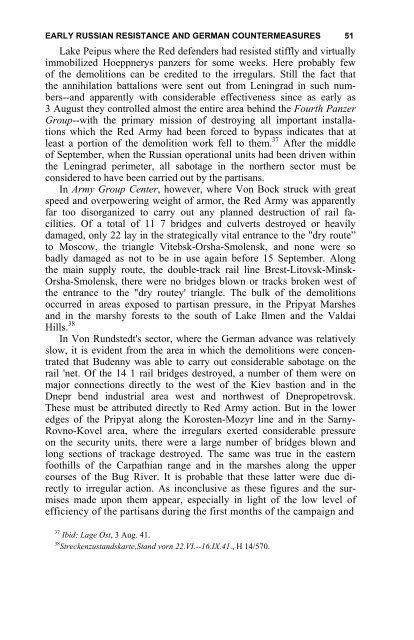the soviet partisan movement 1941-1944 by edgar m. howell
the soviet partisan movement 1941-1944 by edgar m. howell
the soviet partisan movement 1941-1944 by edgar m. howell
Create successful ePaper yourself
Turn your PDF publications into a flip-book with our unique Google optimized e-Paper software.
EARLY RUSSIAN RESISTANCE AND GERMAN COUNTERMEASURES 51<br />
Lake Peipus where <strong>the</strong> Red defenders had resisted stiffly and virtually<br />
immobilized Hoeppnerys panzers for some weeks. Here probably few<br />
of <strong>the</strong> demolitions can be credited to <strong>the</strong> irregulars. Still <strong>the</strong> fact that<br />
<strong>the</strong> annihilation battalions were sent out from Leningrad in such numbers--and<br />
apparently with considerable effectiveness since as early as<br />
3 August <strong>the</strong>y controlled almost <strong>the</strong> entire area behind <strong>the</strong> Fourth Panzer<br />
Group--with <strong>the</strong> primary mission of destroying all important installations<br />
which <strong>the</strong> Red Army had been forced to <strong>by</strong>pass indicates that at<br />
least a portion of <strong>the</strong> demolition work fell to <strong>the</strong>m. 37 After <strong>the</strong> middle<br />
of September, when <strong>the</strong> Russian operational units had been driven within<br />
<strong>the</strong> Leningrad perimeter, all sabotage in <strong>the</strong> nor<strong>the</strong>rn sector must be<br />
considered to have been carried out <strong>by</strong> <strong>the</strong> <strong>partisan</strong>s.<br />
In Army Group Center, however, where Von Bock struck with great<br />
speed and overpowering weight of armor, <strong>the</strong> Red Army was apparently<br />
far too disorganized to carry out any planned destruction of rail facilities.<br />
Of a total of 11 7 bridges and culverts destroyed or heavily<br />
damaged, only 22 lay in <strong>the</strong> strategically vital entrance to <strong>the</strong> "dry route”<br />
to Moscow, <strong>the</strong> triangle Vitebsk-Orsha-Smolensk, and none were so<br />
badly damaged as not to be in use again before 15 September. Along<br />
<strong>the</strong> main supply route, <strong>the</strong> double-track rail line Brest-Litovsk-Minsk-<br />
Orsha-Smolensk, <strong>the</strong>re were no bridges blown or tracks broken west of<br />
<strong>the</strong> entrance to <strong>the</strong> "dry routey' triangle. The bulk of <strong>the</strong> demolitions<br />
occurred in areas exposed to <strong>partisan</strong> pressure, in <strong>the</strong> Pripyat Marshes<br />
and in <strong>the</strong> marshy forests to <strong>the</strong> south of Lake Ilmen and <strong>the</strong> Valdai<br />
Hills. 38<br />
In Von Rundstedt's sector, where <strong>the</strong> German advance was relatively<br />
slow, it is evident from <strong>the</strong> area in which <strong>the</strong> demolitions were concentrated<br />
that Budenny was able to carry out considerable sabotage on <strong>the</strong><br />
rail 'net. Of <strong>the</strong> 14 1 rail bridges destroyed, a number of <strong>the</strong>m were on<br />
major connections directly to <strong>the</strong> west of <strong>the</strong> Kiev bastion and in <strong>the</strong><br />
Dnepr bend industrial area west and northwest of Dnepropetrovsk.<br />
These must be attributed directly to Red Army action. But in <strong>the</strong> lower<br />
edges of <strong>the</strong> Pripyat along <strong>the</strong> Korosten-Mozyr line and in <strong>the</strong> Sarny-<br />
Rovno-Kovel area, where <strong>the</strong> irregulars exerted considerable pressure<br />
on <strong>the</strong> security units, <strong>the</strong>re were a large number of bridges blown and<br />
long sections of trackage destroyed. The same was true in <strong>the</strong> eastern<br />
foothills of <strong>the</strong> Carpathian range and in <strong>the</strong> marshes along <strong>the</strong> upper<br />
courses of <strong>the</strong> Bug River. It is probable that <strong>the</strong>se latter were due directly<br />
to irregular action. As inconclusive as <strong>the</strong>se figures and <strong>the</strong> surmises<br />
made upon <strong>the</strong>m appear, especially in light of <strong>the</strong> low level of<br />
efficiency of <strong>the</strong> <strong>partisan</strong>s during <strong>the</strong> first months of <strong>the</strong> campaign and<br />
37<br />
Ibid; Lage Ost, 3 Aug. 41.<br />
38 Streckenzustandskarte,Stand vorn 22.VI.--16.IX.41., H 14/570.
















